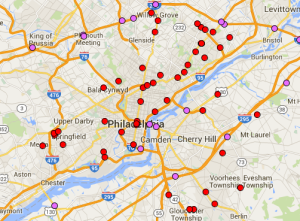
Philadelphia red-light cameras map (Source: Photoenforced.com)
The Philadelphia Parking Authority (PPA) activated their latest addition to the Red-Light Camera Program at 12:01 a.m. on Thursday, Nov. 5. The new cameras at the intersection of Belmont and Parkside Avenues in West Philadelphia mark the 29th location for the program, which now has 126 cameras installed total.
The activation began a 45-day warning period at the intersection. Drivers found in violation during this grace period will receive warnings in the mail, which ends at midnight on December 20. After the period ends, violators will face a $100 fine for each offense.
“This is a heavily traveled intersection that is used by local residents and visitors to several of our city’s cultural institutions,” said Vince Fenerty, PPA’s Executive Director. “These new cameras will make it safer for everyone because drivers will think twice before going through a red light.”
The Pennsylvania General Assembly gave the PPA the power to establish a Red-Light Camera Program in the City of Philadelphia. In 2005, the PPA began equipping intersections with cameras that monitor traffic and automatically photograph vehicles that drive into an intersection after the light has turned red.
The Red-Light Camera Program has helped to reduce dangerous behavior by drivers at chronically troublesome intersections, according to the PPA. At each of the nine locations on Roosevelt Boulevard where the cameras are installed, data shows that the number of violations has decreased. Since the cameras’ first full year of operation, violations at the intersection of the Boulevard and Cottman Avenue have dropped by more than 81 percent.
The Red-Light Camera intersections in the city now include:
1. Grant Avenue and Roosevelt Boulevard
2. Red Lion Road and Roosevelt Boulevard
3. Cottman Avenue and Roosevelt Boulevard
4. 34th Street and Grays Ferry Avenue
5. Broad Street and Oregon Avenue
6. Broad Street and Hunting Park Avenue
7. 58th and Walnut Streets
8. Broad and Vine Streets
9. Broad Street and South Penn Square
10. Broad Street and John F. Kennedy Boulevard
11. Henry Avenue and Walnut Lane
12. Rising Sun and Adams Avenues
13. Aramingo Avenue and York Street
14. Aramingo and Castor Avenues
15. Lindbergh Boulevard and Island Avenue
16. Welsh Road and Roosevelt Boulevard
17. Southampton Road and Roosevelt Boulevard
18. Mascher Street and Roosevelt Boulevard
19. Levick Street and Roosevelt Boulevard
20. Rhawn Street and Roosevelt Boulevard
21. 9th Streets along the Boulevard
22. Academy Road and Grant Avenue
23. Woodhaven and Knights Roads
24. Bustleton Avenue and Byberry Road
25. Byberry and Worthington Roads
26. Stenton and Ogontz Avenues
27. Island and Bartram Avenues
28. N. 2nd Street and Erie Avenue
29. Belmont Avenue and Parkside Avenue







November 13th, 2015 at 11:38 pm
Remember, investigative reporters in 2005 when the program was new and again in 2011 when it was up for renewal got data from the Philadelphia Police Department showing crashes increased at camera intersections. More cameras equals more crashes. The PPA and PennDOT share in the camera revenue which totaled $45 million in 2011 when the program was up for renewal. The total now is over $60 million and even that is not enough for the PPA and PennDOT, so they are adding more cameras for more revenue.
James C. Walker, Life Member – National Motorists Association
November 17th, 2015 at 8:46 am
The largest problem may be the failure to set the timing of the yellow light so it is geared to the prevailing speed of traffic, per DOT standards. Pennsylvania unwisely allows it to be set according to the posted limit. If the speed limit in the area is not set according to legitimate traffic engineering standards, and thus is arbitrary and far lower than most good drivers operate at, what should be a valuable safety tool becomes mostly just a way to raise funds.